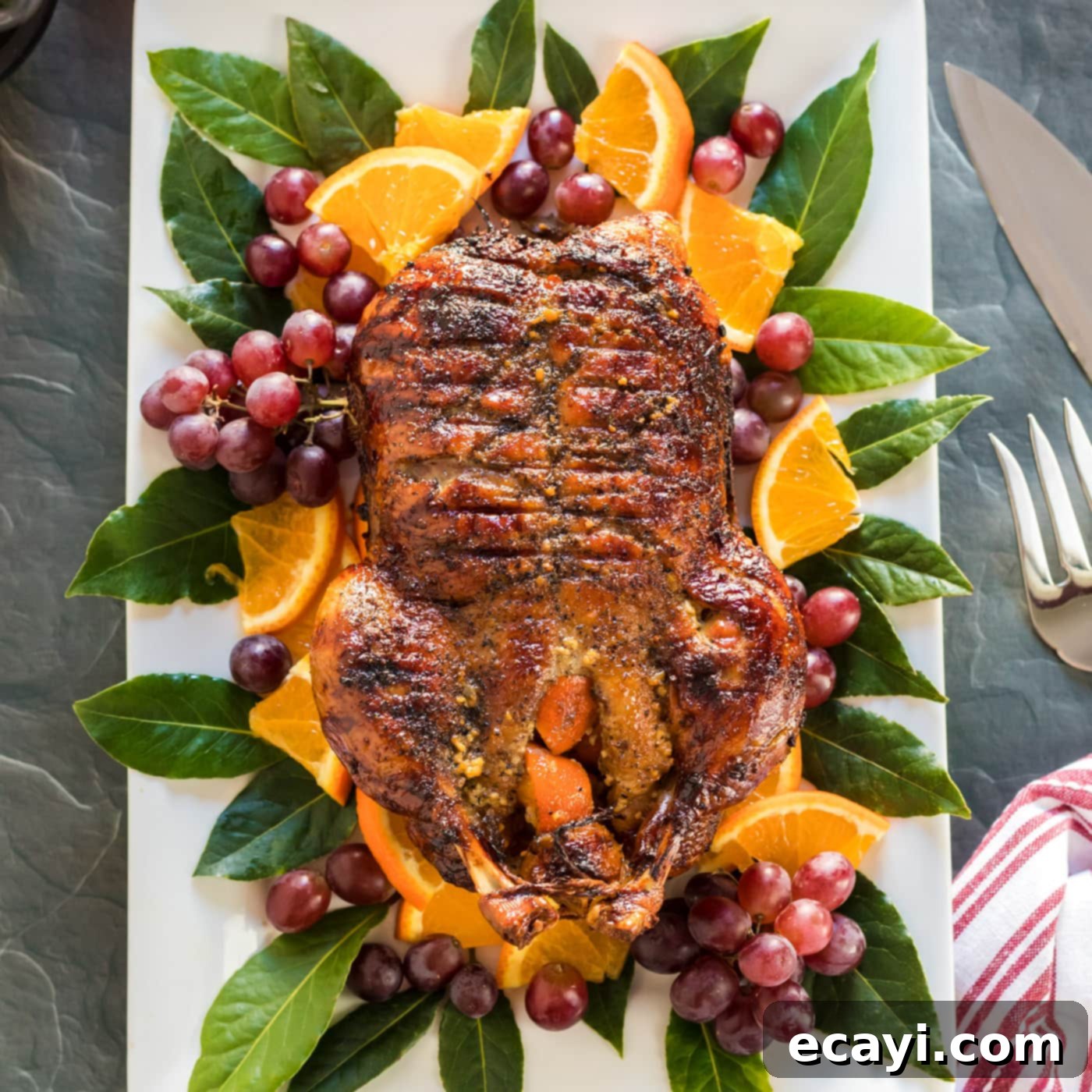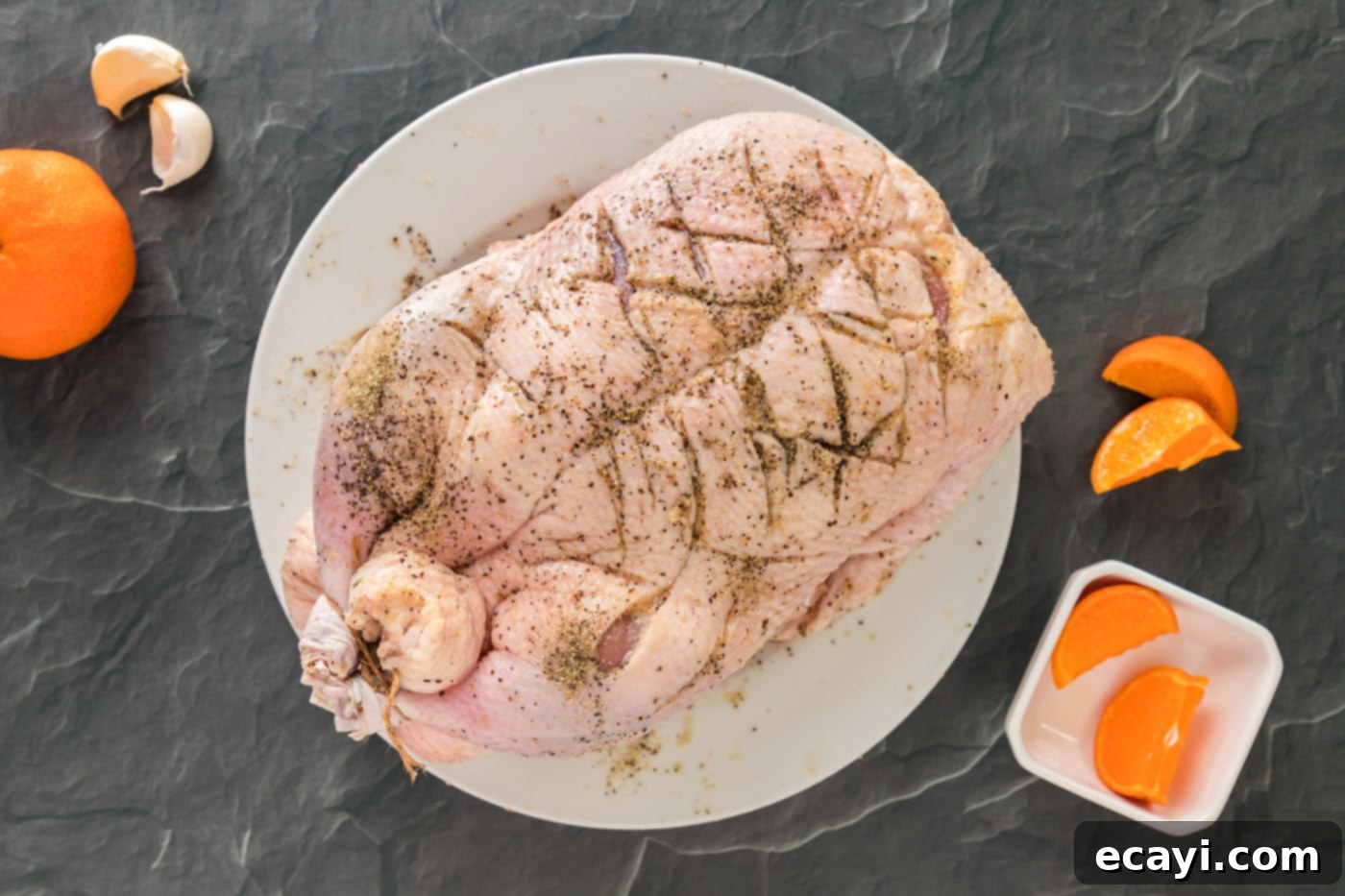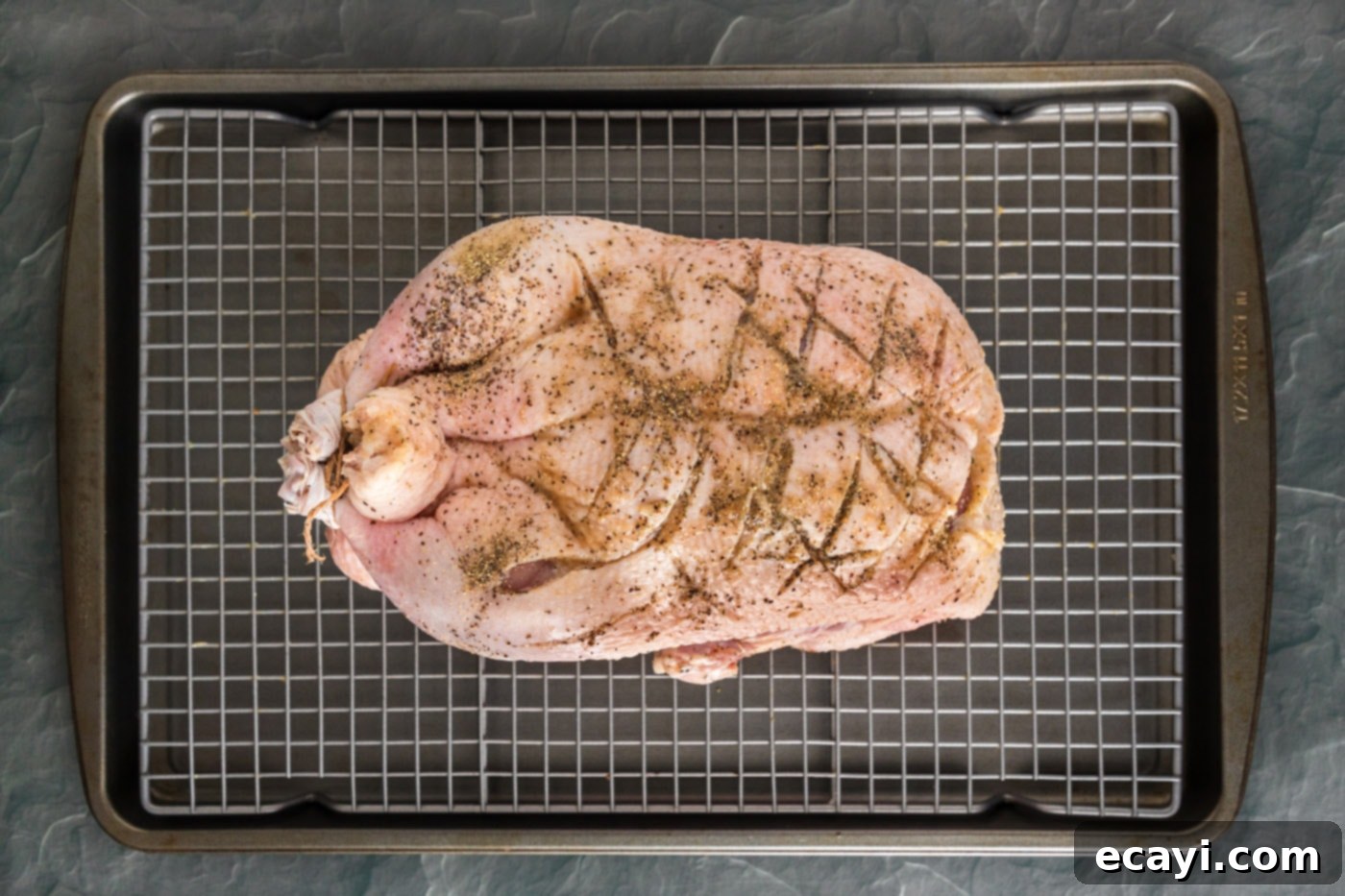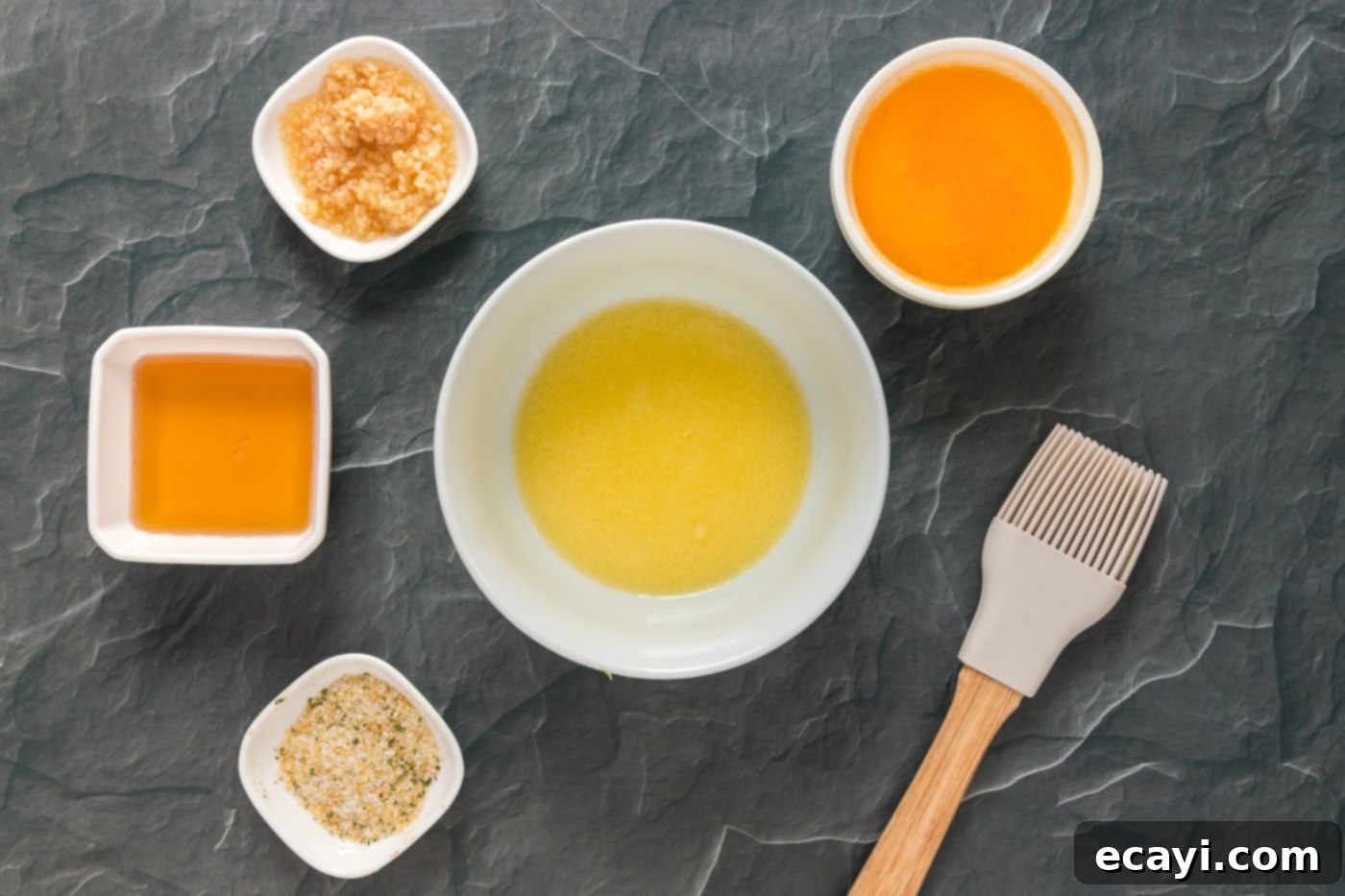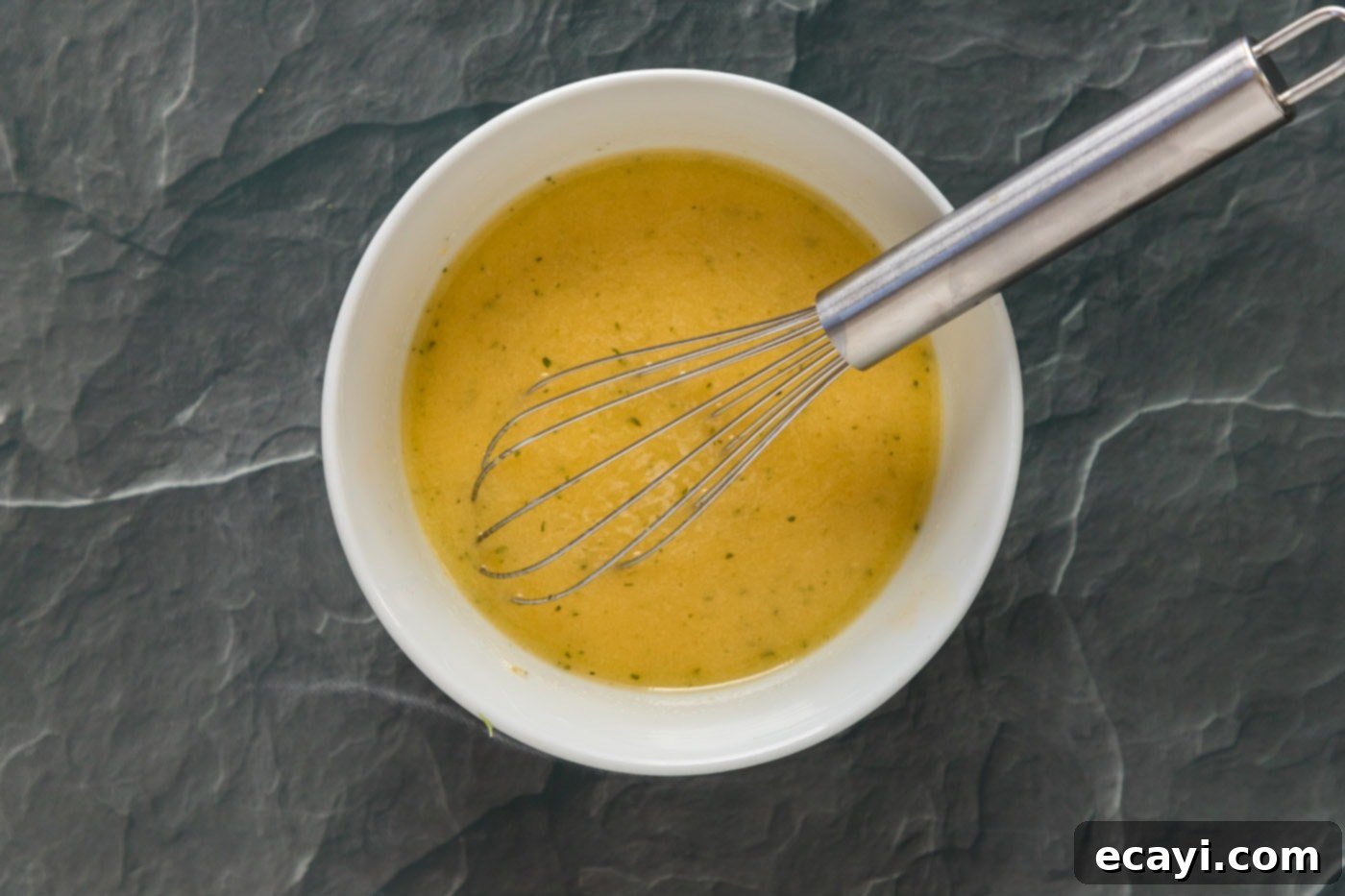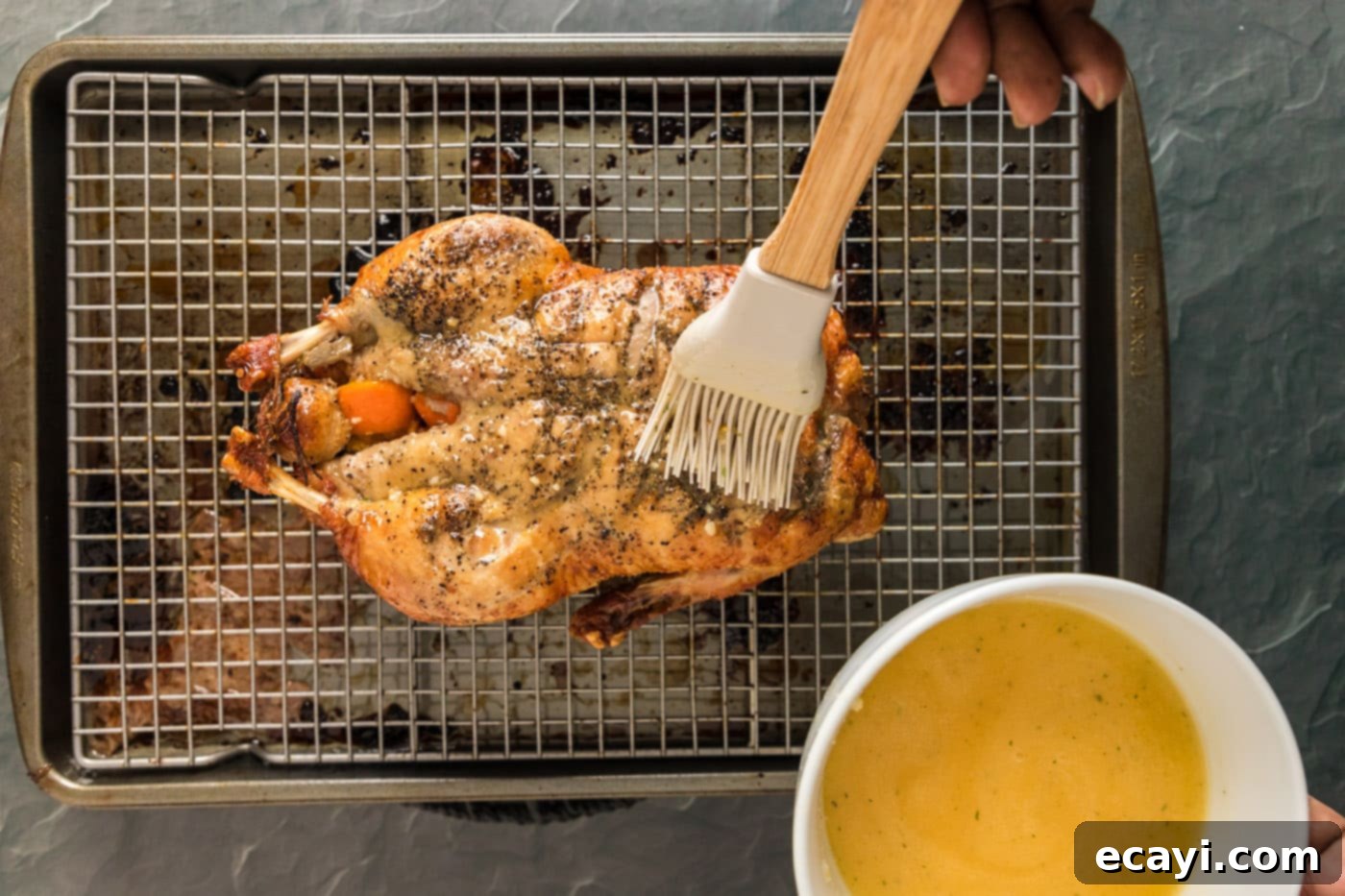Perfect Crispy Roast Duck: Mandarin Orange and Honey Glazed Elegance
Embark on a culinary journey to create the most succulent and flavorful roast duck, featuring an irresistibly crispy, golden-brown skin. This exquisite recipe elevates a classic dish by stuffing the duck with fragrant garlic and sweet mandarin oranges, then basting it generously with a luxurious mixture of rich honey, tangy mandarin juice, melted butter, and aromatic minced garlic. The slow roasting process in the oven ensures the duck’s fat renders beautifully, leading to incredibly juicy meat beneath that signature, shatteringly crisp skin. Prepare to impress your guests and delight your palate with this magnificent centerpiece.
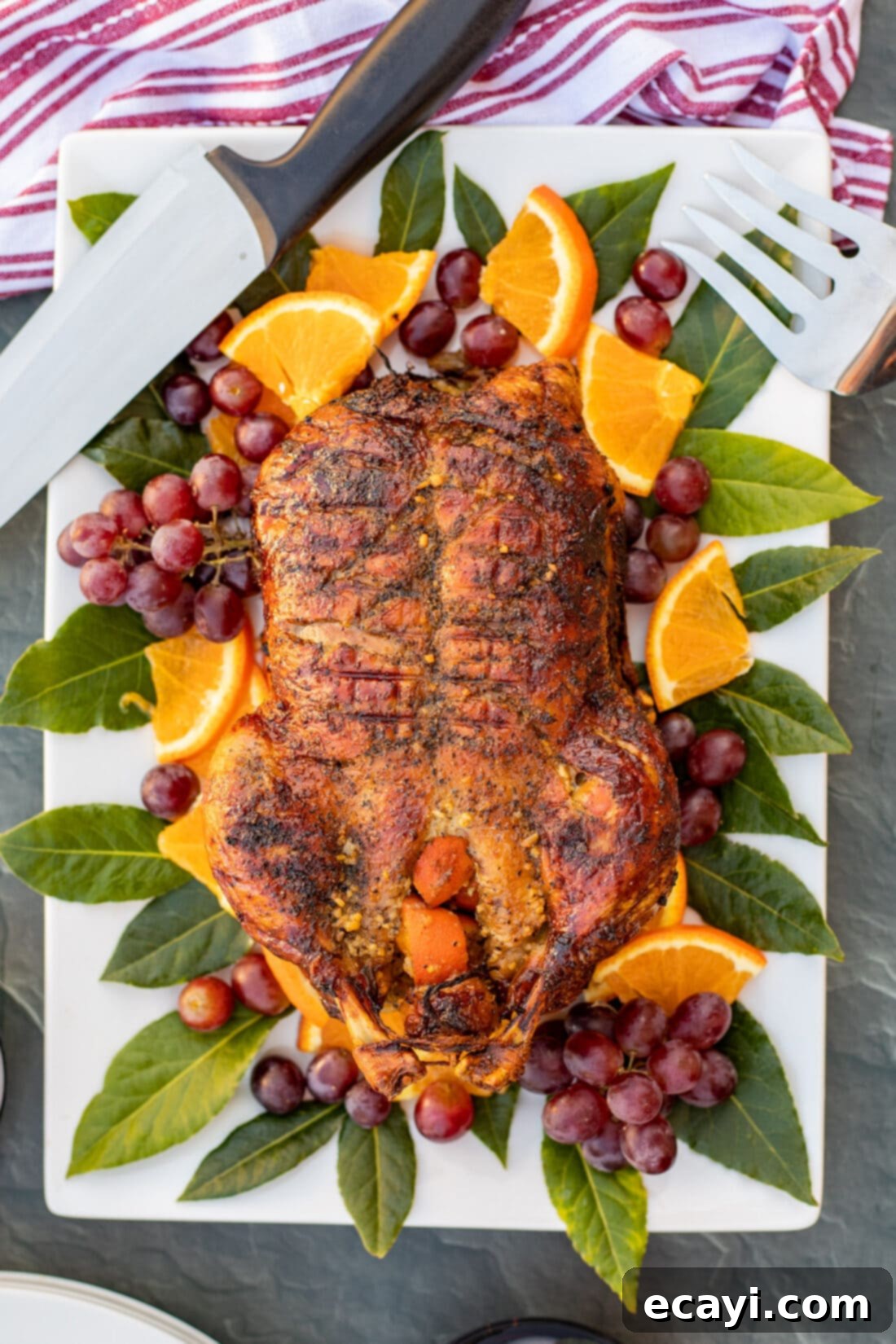
Why This Mandarin & Honey Roast Duck Recipe is a Must-Try
If your heart beats for the rich, robust flavors of dark meat, akin to perfectly cooked chicken thighs and chicken legs, then this crispy roast duck recipe is destined to become a new favorite. While duck is categorized as poultry, its flavor profile and texture lean closer to that of red meat, offering a depth and richness that far surpasses ordinary chicken or pork. This is largely due to its naturally higher fat content, which, when rendered correctly, imbues the meat with unparalleled succulence and flavor.
What truly sets this particular recipe apart is the thoughtful combination of ingredients that enhance duck’s natural qualities. The signature crispy golden skin isn’t just a visual delight; it’s a testament to the meticulous basting with a sweet and tangy blend of honey and mandarin juices. This glaze doesn’t just add a beautiful sheen; it caramelizes to perfection, locking in moisture and infusing the skin with a vibrant, citrusy sweetness that perfectly complements the savory, juicy meat. Mandarin oranges, with their bright and slightly tart notes, expertly balance the duck’s inherent richness, preventing it from tasting overly gamey – a common concern for some. Garlic, both stuffed within the cavity and minced into the basting liquid, provides an aromatic foundation, adding layers of savory depth that complete this truly gourmet experience. Slow roasting ensures the fat renders gradually, yielding the crispest skin imaginable while keeping the meat incredibly tender and moist. This isn’t just a meal; it’s a celebration of flavor and texture, perfect for special occasions or when you simply crave something extraordinary.
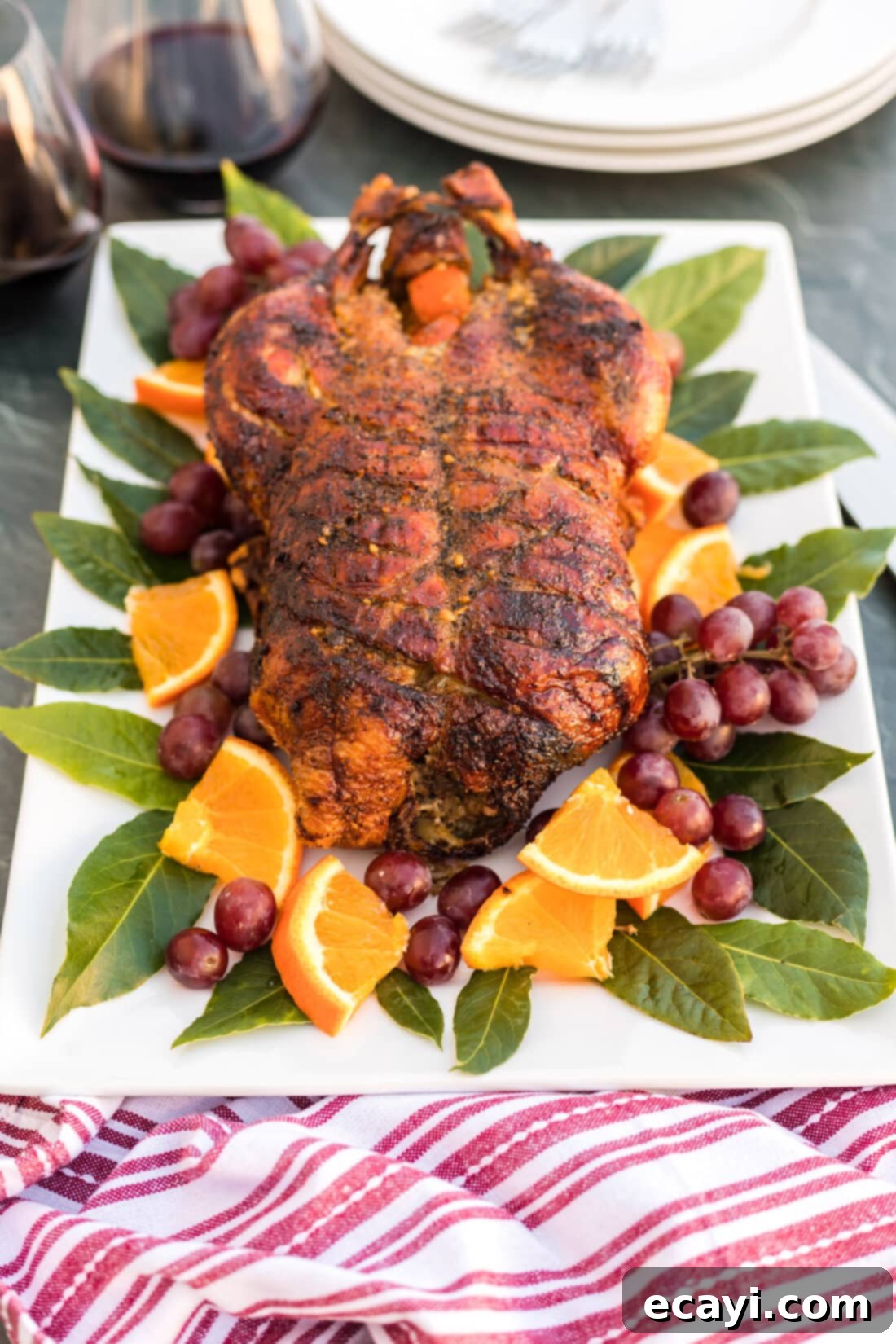
Essential Ingredients for Your Crispy Roast Duck
Crafting a truly memorable roast duck begins with selecting quality ingredients. For exact measurements, a comprehensive list, and detailed instructions, please refer to the printable version of this recipe conveniently located at the end of this post. Here’s a quick overview of what you’ll need to gather:
- Whole Duck (typically 5-6 pounds, often Pekin/Long Island duck)
- Garlic Salt & Black Pepper
- Mandarin Oranges (for stuffing and juicing)
- Whole Garlic Cloves (for stuffing)
- Unsalted Butter (melted, for basting)
- Honey (for basting)
- Minced Garlic (for basting)
Choosing a good quality duck is paramount. Look for a fresh or frozen whole duck from a reputable butcher or grocery store. Ensure it’s defrosted thoroughly if frozen, preferably in the refrigerator over 2-3 days for larger ducks. The mandarins should be ripe and fragrant, offering plenty of juice and natural sweetness.
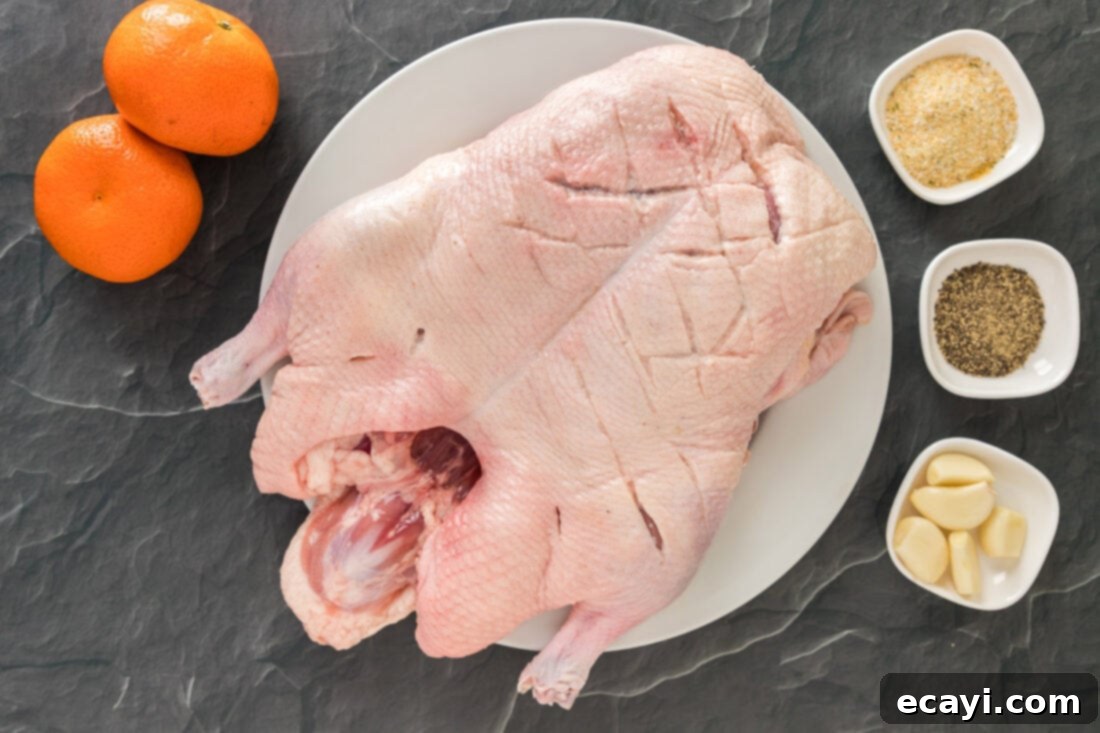
Ingredient Spotlight: Tips for Optimal Flavor and Texture
Understanding each ingredient’s role is key to mastering this roast duck. Here’s a closer look, along with some helpful tips and substitution suggestions:
Mandarins (Oranges)
For this recipe, we specifically recommend using mandarin oranges, often found as “Cuties” or “Halos.” Their smaller size and sweeter, less acidic profile are ideal for balancing the rich, sometimes gamey, flavor that duck can possess. Mandarins infuse a delicate, refreshing citrus note into the meat from the inside out when stuffed in the cavity, and contribute a delightful tang and sweetness to the basting glaze. This combination makes them an excellent accompaniment to the savory duck. While other oranges like navel oranges can be used in a pinch, be aware they are typically larger and more acidic, which might slightly alter the flavor balance. If using larger oranges, you might consider using less of the juice in the basting mixture to prevent it from becoming too tart. Lemon or lime zest could offer a different citrus twist, but the unique sweetness of mandarins truly shines here.
Duck (The Star of the Show)
A whole duck, typically a Pekin or Long Island duck, is the foundation of this recipe. Ducks are known for their generous layer of fat, which is precisely what contributes to their rich flavor and the highly coveted crispy skin. During the slow roasting process, this fat renders down considerably. Don’t be alarmed by the amount of fat – it’s crucial for both taste and texture. Scoring the duck skin in a diamond pattern is a vital step; it creates channels for the fat to escape more efficiently during cooking, allowing the skin to crisp up beautifully without becoming greasy. This also prevents the skin from shrinking too much and keeps the meat moist. You can choose to drain off the rendered fat halfway through cooking if desired, especially if you plan to use it for other culinary purposes, like roasting potatoes or vegetables later. The rendered duck fat is liquid gold, full of flavor! Embrace the fat content; it’s what makes duck so incredibly delicious and flavorful compared to leaner poultry.
Honey and Butter
These two ingredients form the heart of our luscious basting mixture. Honey provides a natural sweetness that encourages beautiful caramelization of the duck skin, leading to that desirable golden-brown color and enhanced crispiness. It also adds a complex, earthy sweetness that pairs wonderfully with the mandarin and garlic. Butter contributes richness and helps the skin brown evenly, ensuring a moist and flavorful exterior. When combined with mandarin juice and minced garlic, they create a glaze that continuously builds flavor and keeps the duck succulent throughout the roasting process. For substitutions, maple syrup could offer a different sweet note, but honey’s viscosity and flavor are preferred. Vegan butter could be used, but the richness of dairy butter is hard to replicate.
Garlic
We utilize garlic in two forms in this recipe: whole cloves for stuffing and minced garlic for the basting mixture. The whole cloves, tucked inside the duck cavity along with the mandarin quarters, gently infuse the meat from within with their aromatic essence as the duck roasts. This creates a subtle, underlying garlic flavor that isn’t overpowering but adds considerable depth. The minced garlic in the basting sauce, on the other hand, contributes a more direct and potent garlicky punch to the skin and surface of the meat. This dual approach ensures a harmonious and well-rounded garlic presence throughout the entire dish. Fresh garlic is always recommended for the best flavor.
Mastering the Art of Roasting Crispy Duck
These step-by-step photos and instructions are here to help you visualize how to make this recipe. For the printable version of this recipe, complete with precise measurements and instructions, you can Jump to Recipe at the bottom of this post.
- **Prepare Your Oven and Equipment:** Begin by preheating your oven to 350°F (175°C). This ensures a consistent temperature from the moment the duck enters. Place a wire rack directly inside a baking sheet. This setup is crucial for allowing the duck’s fat to drip away as it renders, preventing the duck from sitting in its own grease and ensuring maximum crispiness.
- **Prepare the Duck:** Carefully remove any giblets (neck, liver, gizzards) from the duck’s cavity. While some recipes utilize giblets for gravy or stock, we will not be using them in this particular recipe. Pat the duck thoroughly dry with paper towels; this is a critical step for achieving truly crispy skin.
- **Score the Skin:** Place the duck breast side up. Using a very sharp knife, carefully score the skin in a diamond pattern across the entire breast and thighs. The goal is to cut through the skin and fat layer, but crucially, avoid cutting all the way into the meat. Scoring helps the fat render more efficiently and allows the basting liquid to penetrate, contributing to a crispier, more flavorful skin.
- **Season Generously:** Season the scored skin all over with garlic salt and black pepper. Be sure to rub the seasoning into the scored lines. You may not need to use all of the seasoning provided in the recipe; adjust to your preference. This initial seasoning forms the base layer of flavor.

- **Stuff the Cavity:** Stuff the duck’s cavity with the quartered mandarin oranges and whole garlic cloves. These aromatics will slowly release their flavors into the duck as it cooks, infusing the meat with a beautiful, subtle citrus and garlic essence.
- **Secure the Duck:** Use butcher’s twine to tie the duck’s legs together. This helps the duck maintain a compact shape during roasting, promoting more even cooking and a neater presentation.
- **Initial Roasting Position:** Place the prepared duck on the wire rack (on the baking sheet), ensuring it is breast side up. This allows the hot air to circulate around the duck and the rendered fat to drip down into the pan below, rather than pooling around the duck and making it soggy.

- **First Stage of Roasting:** Bake the duck, breast side up, for one hour. After this time, remove the duck from the oven and carefully turn it over so it is breast side down. Return it to the oven and bake for another hour. This initial turning helps to render fat from both sides evenly, ensuring uniform crispiness.
- **Prepare the Basting Mixture:** While the duck is in its second hour of baking, prepare the flavorful basting mixture. In a medium bowl, whisk together the melted butter, honey, mandarin juice, minced garlic, and any remaining garlic salt and pepper from your initial seasoning (if you have any left). This creates a sweet, savory, and aromatic glaze.


- **First Basting Phase:** After the two hours of initial baking, remove the duck from the oven. Flip it over once more so it is breast side up. Using a pastry brush, generously brush the duck with some of the prepared melted butter mixture. This step initiates the glazing and caramelization process. Return the duck to the oven and continue baking for 40 minutes.

- **Second Basting Phase:** Remove the duck from the oven again and flip it so that it is breast side down. Brush it with more of the delicious melted butter mixture. Place it back in the oven for another 40 minutes. This alternating basting and flipping technique, similar to a rotisserie, ensures every inch of the duck skin becomes incredibly crispy and beautifully glazed.
- **Rest Before Serving:** Once fully roasted and wonderfully golden, remove the duck from the oven. It’s essential to allow the duck to rest for 5-10 minutes before carving and serving. This resting period allows the juices to redistribute throughout the meat, ensuring every slice is as tender and succulent as possible.
Frequently Asked Questions & Expert Tips for Perfect Roast Duck
Store any leftover roast duck in an airtight container, refrigerated, for up to 2 days. For longer storage, cooked duck can be frozen for up to 2-3 months. Reheat gently in the oven to help crisp the skin again, or slice and use in stir-fries, salads, or sandwiches.
Beyond scoring and the wire rack, patting the duck extremely dry with paper towels before seasoning is paramount. Moisture on the skin will steam rather than crisp. You can also lightly sprinkle with a little baking powder mixed with salt before roasting (about 1/2 tsp per duck) for a chemical reaction that aids crisping. A final blast of high heat (400-425°F) for 10-15 minutes at the very end of cooking, after basting, can also help achieve maximum crispiness.
Don’t discard it! Rendered duck fat is a culinary treasure. Strain it through a fine-mesh sieve into a clean jar and store it in the refrigerator for months. It’s fantastic for roasting potatoes (duck fat roasted potatoes are legendary!), sautéing vegetables, making confit, or even enriching gravies and sauces. Its high smoke point and rich flavor make it a gourmet cooking medium.
The most reliable way to check for doneness is to use an instant-read meat thermometer. Insert the thermometer into the thickest part of the thigh, avoiding the bone. The internal temperature should reach 165-170°F (74-77°C). The juices should also run clear when the thigh is pierced. Due to duck’s fat content, a slight pinkness near the bone is acceptable, especially in the breast, but the thighs should be thoroughly cooked.
Yes, you can do some prep work ahead of time. You can pat the duck dry, score the skin, and season it up to 24 hours in advance. Keep it uncovered in the refrigerator on the wire rack over a baking sheet. This also helps to further dry out the skin, contributing to a crispier finish. You can also prepare the basting mixture a day ahead and store it in the fridge, warming it gently before use.
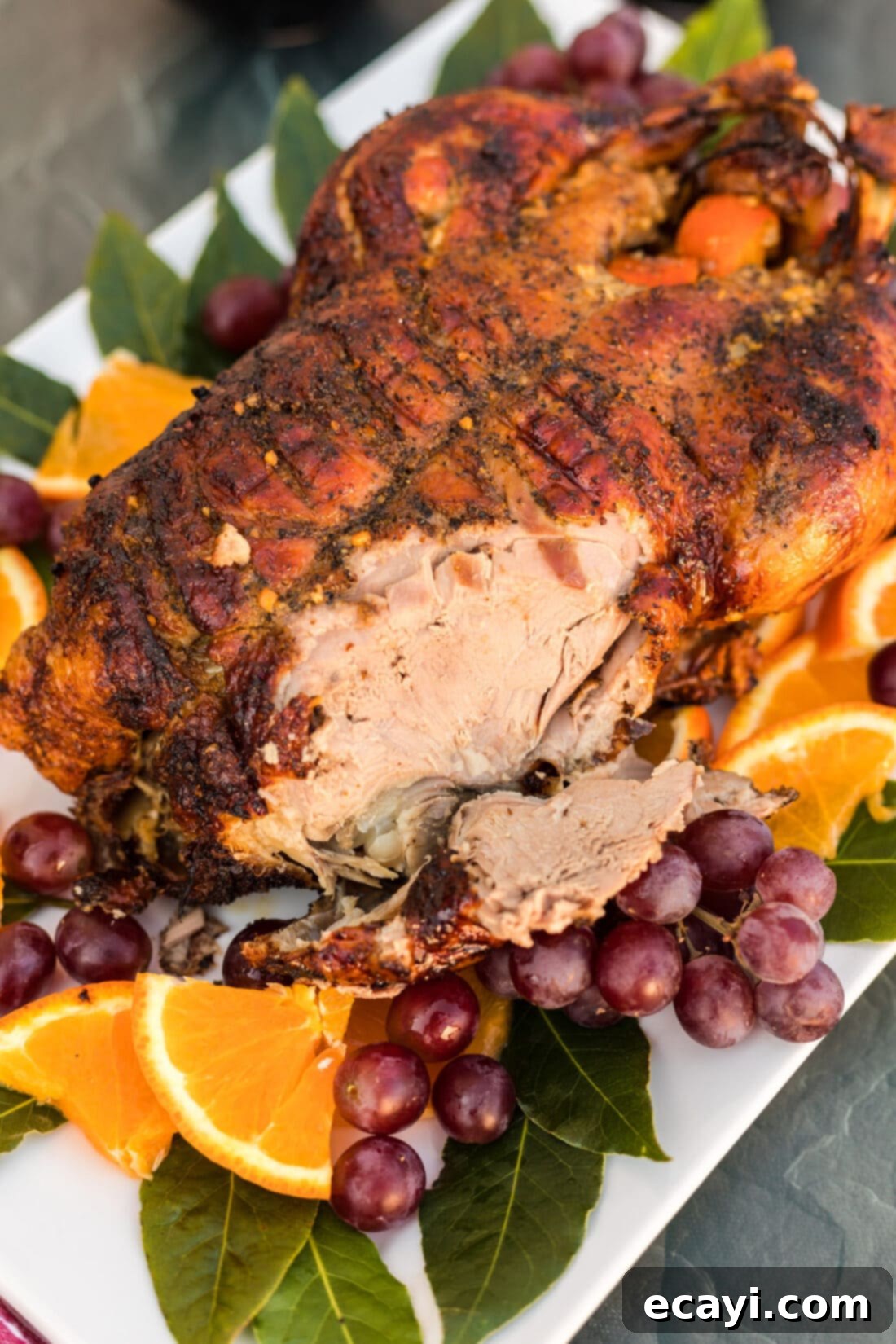
Elegant Serving Suggestions for Your Roast Duck
Once your magnificent roast duck emerges from the oven, glistening and golden, presentation is key to completing the culinary experience. Carve the duck into portions or whole pieces, then arrange it artfully on a large platter. Garnish with fresh mandarin orange slices and vibrant fresh grapes for a beautiful and edible decoration that echoes the flavors within the dish. Fresh herbs like rosemary or thyme sprigs can also add a touch of greenery and aromatic appeal.
Roast duck is a versatile centerpiece that pairs exceptionally well with a variety of side dishes. For starches, consider classic roasted potatoes (especially if roasted in some of that glorious rendered duck fat!), creamy mashed potatoes, or a fluffy wild rice pilaf. To balance the richness, roasted root vegetables such as carrots, parsnips, and sweet potatoes tossed with a touch of honey will complement the flavors beautifully. Other excellent vegetable accompaniments include tender-crisp asparagus, vibrant green beans almandine, or sweet and savory glazed carrots. For a lighter touch, a crisp green salad with a citrus vinaigrette can cut through the richness. Don’t forget a simple pan sauce made from the deglazed pan drippings for an extra layer of flavor. For beverages, a robust Pinot Noir, a fruity Syrah, or even a crisp hard cider would make excellent pairings.
Discover More Delectable Roasted Poultry and Meat Recipes
If you enjoyed the experience of roasting this delicious duck, you might be interested in exploring other magnificent roasted dishes. These recipes are perfect for gatherings, holidays, or simply elevating your everyday meals:
- Classic Roasted Chicken
- Perfect Roasted Turkey
- Sweet and Savory Orange Bourbon Glazed Ham
- Succulent Slow Roasted Sticky Chicken with Roasted Vegetables
I love to bake and cook and share my kitchen experience with all of you! Remembering to come back each day can be tough, that’s why I offer a convenient newsletter every time a new recipe posts. Simply subscribe and start receiving your free daily recipes!
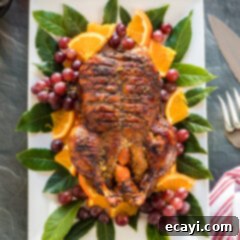
Roast Duck
IMPORTANT – There are often Frequently Asked Questions within the blog post that you may find helpful. Simply scroll back up to read them!
Print It
Pin It
Rate It
Save ItSaved!
Ingredients
- 5 ¼ pound duck
- 1 Tablespoon garlic salt
- ½ Tablespoon black pepper
- 6 mandarin oranges quartered, AKA cuties. PLUS more for juices
- 5 cloves garlic whole
- 4 Tablespoons butter melted
- 3 Tablespoons honey
- ½ cup mandarin juice from about 2-3 mandarins
- 1 Tablespoon minced garlic
Things You’ll Need
-
Wire cooling rack
-
Baking sheet
-
Pastry brush
-
Vinyl gloves
Before You Begin
- The duck will render quite a bit of fat. You can drain off the fat halfway through cooking if you like. This rendered duck fat is excellent for roasting potatoes or vegetables!
- The reason we are flipping the duck is to mimic the process of a rotisserie, ensuring all sides cook evenly and the skin crisps up beautifully from every angle.
- Store leftover roast duck in an air-tight container kept in the refrigerator for up to 2 days.
- For the crispiest skin, ensure the duck is thoroughly patted dry before scoring and seasoning.
Instructions
-
Preheat oven to 350 F. Place a wire rack inside a baking sheet.
-
Remove any giblets from the duck. We are not using the giblets in this recipe.
-
With breast side up, carefully score the skin in a diamond pattern. Try not to cut too deep, it’s best not to cut all the way through to the meat.
-
Season the skin with garlic salt and pepper. You may not use all the seasoning.
-
Stuff the cavity with quartered mandarin oranges and garlic cloves.
-
Use butcher’s twine to tie the legs together.
-
Place duck on wire rack (on baking sheet). The wire rack will allow the rendered fat to drip through to the pan, while not saturating the duck.
-
Bake, breast side up, for one hour. Remove from oven and turn duck over, breast side down, bake another hour.
-
In a medium bowl, whisk together melted butter, honey, mandarin juice, minced garlic, and any remaining garlic salt and pepper (if any).
-
Remove duck from oven and flip over so that duck is breast side up. Brush the duck with some of the melted butter mixture and put back in the oven for 40 minutes.
-
Remove duck from oven and flip over so that duck is breast side down. Brush the duck with more of the melted butter mixture and put back in the oven for 40 minutes.
-
Remove from oven and allow to rest 5-10 minutes before serving.
Nutrition
The recipes on this blog are tested with a conventional gas oven and gas stovetop. It’s important to note that some ovens, especially as they age, can cook and bake inconsistently. Using an inexpensive oven thermometer can assure you that your oven is truly heating to the proper temperature. If you use a toaster oven or countertop oven, please keep in mind that they may not distribute heat the same as a conventional full sized oven and you may need to adjust your cooking/baking times. In the case of recipes made with a pressure cooker, air fryer, slow cooker, or other appliance, a link to the appliances we use is listed within each respective recipe. For baking recipes where measurements are given by weight, please note that results may not be the same if cups are used instead, and we can’t guarantee success with that method.
